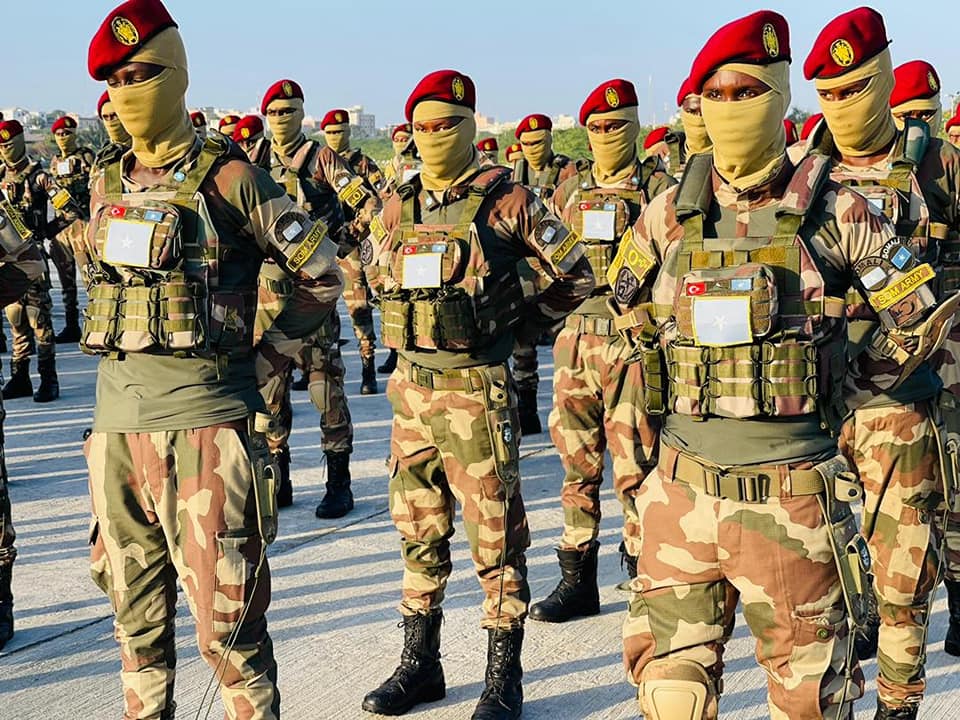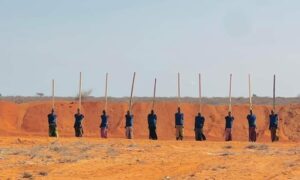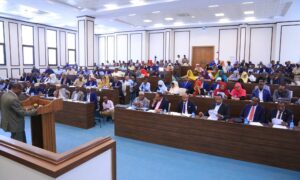31.01.2022: Mogadishu, Somalia
With the African Union Mission in Somalia drawing to another legal end, the question arises as to what the purpose and mission of AMISOM in Somalia is beyond 2022?
The African Union Mission has been involved in Somalia peace process for over a decade, having played a pivotal role in removal of Al-Shabaab from major towns and cities during the late 2000s and early 2010s.
However, what is important to understand is that the political and security dynamic in Somalia has drastically changed since 2010s.
Today, one can see a functioning army, albeit it is quite a small army. However, it is evident these units are able to take the lead in security operations across the South. This has been all the more evident in 2021, with the Somali security forces liberating the majority of Southern Mudug from Al-Shabaab militants, killing over 200 as well as liberating over 16 towns and cities in the space of a month.
The reality is that the African Union Mission has not really been involved in serious security operations in Somalia over the last three years.
Conversely, the Somali government has spent a large amount of effort, time and money in rebuilding a Somali national army that is able to defend the nation against both internal and external threats.
We have seen the training of 1000s of fresh young Somalis from across the nation into specialist units ranging from Gorgor Commandos to Danab and Warran. The Somali security forces continue to develop and based on the current trajectory, it seems as though the current progress is concurrent with the Somali Transition Plan as endorsed by the United Nation Security Council.
Therefore, the question becomes: why was the AU so desperate for the continuation of the mission beyond the agreed upon timeframe and instead until 2026?
Before we get into that, let’s understand how AMISOM is funded:
- 100% of AMISOM salaries come from Europe, with the European Union paying around 90% of salaries and UK paying roughly 10%.
- More than 90% of the AUPS budget is financed through the EU’s African Peace Facility.
- In fact, since the EU’s APF was established in 2004, the EU has committed more than €1.1 billion.
- The AMISOM mission which has been in Somalia since 2007 absorb more than 85% of the APF spending.
- Consequently, in 2016, the EU cut the AMISOM budget by 20% which saw angry reactions from African countries in AMISOM
- Indeed, the EU cited competing priorities in Africa including the need to shift resources into training the Somali National Army.
This is a powerful point as the security situation in Somalia has shifted from a failed state to a state with functioning governmental departments and security forces, even if it is in its early stages.
As a result, it makes sense both financially and politically to help support the Somali National Army as it would help Somalia stand on its own two feet rather than rely on foreign forces that require outrageous financial expenditure yet have not shown much in the past 5 years in terms successful campaigns.
Training the Somali Army will be beneficially for two reasons:
- It will be more cost effective.
- It will allow Somalia to recuperate much faster, with the need for a peace keeping mission being rendered obsolete.
Now, aside from the EU budget, the UN also provides a non-lethal logistics life support package that includes fuel, food and health services.
What does the AU want?
The debate regarding the AU mission in Somalia was ragging last year at the UN with varies sides having various opinions.
Sources close to Behind the Scenes have confirmed that the AU initially argued for a one year extension to its mandate early 2021, as it does every year. However, the European states had rejected such a proposal. As aforementioned, the EU has already spent billions of Euros in the AMISOM project but is not seeing genuine results.
Such a position was also endorsed by the United States and the Somali government. This would pass as a UN resolution which would give the AMISOM mandate until 2022
Now, the UN conducted an independent assessment of AMISOM outlined 4 possible steps forward for the African Union Mission post 2021:
- The Creation of an UN-AU hybrid mission funded entirely by the UN.
- AMISOM mission is only reconfigured in terms of new goals and objectives.
- The Creation of a new African force.
- AMISOM exit Somalia.
The independent assessors elucidated that the AMISOM mission cannot leave at the moment and have highlighted a few incidents as to why:
- Most particularly, the crisis in Mogadishu earlier this year. The assessors suggested the militia that was formed in the capital against the government demonstrated the lack of cohesion within the armed forces to maintain the security of the nation as a whole.
The African Union rejected the UN proposals and began their own assessment. In contrast to the UN which consulted with the Somali govt prior to endorsing the STP, the AU had engaged in its own independent assessment of Somalia which excluded the host state.
Upon consultations amongst AUPSC members only, the AU released a statement endorsing a hybrid model and have unequivocally stated in the report that not only are Somali leaders incompetent but the Somali armed forces are unable to maintain security in the nation. Consequently, the AU has proposed that the AMISOM mission remains until 2026, with a possible increase in troops and expenditure.
The reality is that for these African countries, it is beneficial both financially and politically for the AMISOM mission to be maintained:
- The AMISOM mission provides millions of dollars annually to the AUPS budget
- The mission also provides salaries to member state soldiers
- The mission provides a substantial amount of unaccounted money to member states.
- Military presence in the horn of Africa
Consequently, losing such a lucrative arrangement would be detrimental to some countries that have a vested interest in Somalia or the surrounding region. This is specifically the case for Kenya.
Diplomatic sources close to Behind the Scenes have informed us that the Kenyan team at both the AUPSC as well as the UN have been working around the clock to undermine Somalia and the ICJ case by obtaining some sort of political or military leverage.
We can see the recent rhetoric coming out of Nairobi, with the President Kenyatta stating that Kenya would defend what it perceives as its territory and calls the ICJ incompetent.
The presence of KDF forces in Somalia is of a major interest for Kenya for example. This would allow Kenya access to Somali territory in Jubaland which Nairobi already heavily influences as outlined by the President in his speech two weeks ago. It also Kenya with access to the disputed waters that was rightfully returned to Somalia which Kenya has categorically rejected.
Therefore, it is evident that it is in the best interest of Kenya to maintain this security mission beyond 2021 at all costs for example.
What about the Somali Govt?
The Somali government has rejected such proposals. The Somali Ministry of Foreign Affairs expressed dismay at the communiqué released by the AUPSC on Oct 7th 2021 in which the hybrid model was endorsed, labelling the AU actions as a path of “destruction and delay” rather than “cooperation”.
The Somali govt further outlined that such hybrid proposals do not align with the Somali govt security strategy as the host nation and the Somali Transition Plan that was endorsed by the UNSC.
Indeed, the AU and Somali govt held talks in Mogadishu between the 12th and 14th of October 2021 in which discussion were held regarding a joint statement and plan forward that respects Somali security interests.
Sources close to the talks confirmed to Behind the Scenes that the AU remained reluctant to discuss the exact nature of the mission but rather were more interested in the operations and funding among other things.
The inability to see eye to eye regarding the duration and purpose of the mission meant that the 2021 talks collapsed with the Ministry of Defence and the AUPSC going back forth regarding the status of the mission.
What to expect next?
Despite the will of the Somali government as the host nation and the plans endorsed at the UNSC as well as objections from major donors including the EU and US, the African Union seems to consistently persist on its model of the mission including its duration and funding.
The reality is that the African Union could never impose such a model without the consent of the Somali government. Hence, why this election is pivotal to the future of Somalia
In fact under UN charters, it clearly stipulates that any peacekeeping force must have the permission of the host nation. Therefore, the imposing of any mission without the consent of the host nation would amount to an occupying force.
In addition, the UN as well as the EU and US all support the Somali government on its security policies. Consequently, for the AUPS to overstep its legal boundaries would portray an image of a more sinister intention in Somalia. The ICJ verdict and the Kenyan response also does not help the image of the AU as it can be perceived as less of a neutral, pan-African organisation but rather a biased one, with allegiances to some nations over other.
This would discredit and damage the AU reputation on the international stage.
Ultimately, as we have seen in 2021, any attempt by the AU to impose its proposals would be met with swift rejection by Somalia. The STP is already a model imposed and in action within Somalia. Both the government in Mogadishu and the international partners at the UN are content with the arrangement.
Recent talks held by the Somali Government with its AUPSC counterparts does indicate positivity with plans expected to be implemented by April 2022 as the mandate of AMISOM ends.
We can only wait and see on the new arrangements.
For regular updates on Somalia follow Suldan Mohamed and Horufadhi Media on Social Media.







